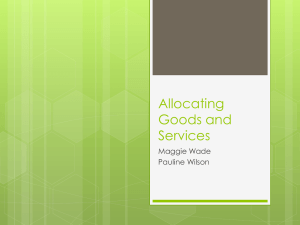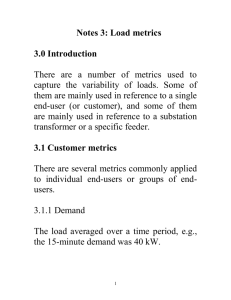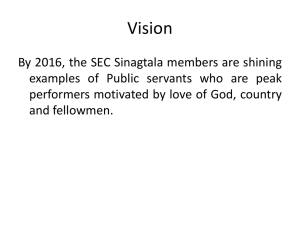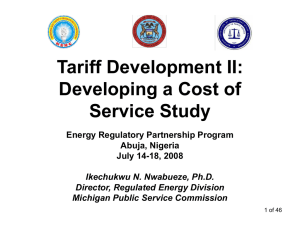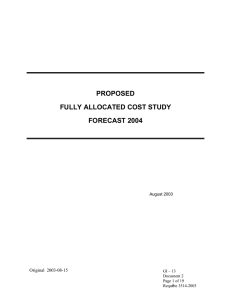Chapter 6 Cost Allocation
advertisement
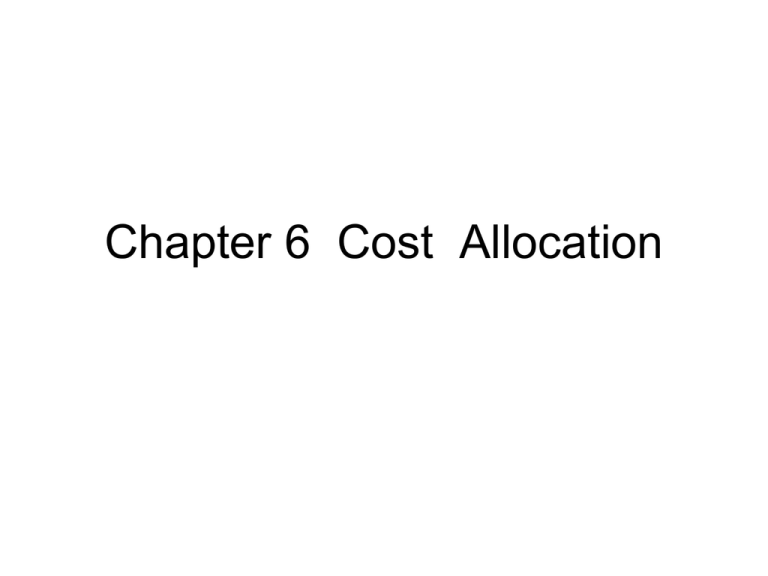
Chapter 6 Cost Allocation 6.1 Introduction • This chapter refers to the next three steps of the “fivestep procedure” , deciding how the revenue requirement is eventually allocated into different customer bins. • To create a Cost-of-Service (COS) model, the firm’s costs are accounted for in three steps: (1) all known and measurable costs distributed into functional categories— cost functionalization. (2) further classified into specific categories-- Classification customer costs; variable costs; fixed costs. (3) classified costs allocated among customer groups (most controversial step: there is no uniformly correct ways of allocating joint and common costs) 6.2 Cost Functionalization • Step 2 of the tariff-making procedure. • FERC established Uniform System of Accounts for this purpose. • Importance of cost functionalization: (1) avoid inefficient and inequitable cost-subsides bw regulated and non-regulated services—eliminating “spillovers” (2) critical to efficient rates even in the absence of unregulated activities. • For easily allocable costs (the majority), functionalization is usually straightforward. Ex: the cost of building and maintaining a 500-kV electric transmission line—transmission category. • For non-allocable costs, or “administrative and general” (A&G) costs, functionalizing is challenging. Ex: accounting costs, office costs (rent, etc.) --requires additional analysis to identify the corresponding activities. • Methods (for non-allocable costs): (1) Kansas-Nebraska method: --allocate each cost account to either labor or plant. Features: standardizes functionalization; provides both consistency and predictability. Typically, when this method is used, the majority of accounts are categorized as labor. (2) Massachusetts method: --expands Kansas-Nebraska method by taking into account derived revenues as a third factor. Three factors are given equal weights. Table: simplified version of functional & classified costs. Each row: one cost function Each column: one cost classification Function Classification Production Capital costs Fuel costs O&M costs Transmission Rights of way Capital costs Payments to grid operators Distribution Three trimming Electric poles Meters Administrative& General (A&G) Office leasing Health care Employee salaries Accounting Billing system Postage Collection agency fees 6.3 Cost Classification (1) Variable costs: --dependent on the amount of a regulated firm’s output or sales. (2) Fixed costs: --incurred regardless of output (3) Customer costs: --directly incurred by customers and can be categorized by customer types. The optimum method of classifying costs also includes an allocation mechanism to deal with accounts comprising a mix of both fixed and variable costs. 6.4 Cost Allocation • The process of matching the different types of classified costs to different groups of customers. • Arguably most difficult step: (1) how to determine appropriate factors (2) appropriate factors now may not be appropriate in later cases • Controversies: (1) must confront not only economic efficiency, but also questions of fairness. --allocation of joint costs (2) when costs are allocated based on another fundamental economic principle: avoiding cross subsidies --hard to estimate; conflict with “just and reasonable” (3) when avoiding cross-subsidies clashes with another principle: allocating costs to those customers who benefit from the expenditures --definition of “benefit” Cost Allocation Methodologies • Allocating variable costs: straightforward. --based on volumetric measures. (w.r.t. output) • Allocating fixed costs: more difficult. --many joint or common costs, no unique method controversies. -- Principle hard to follow: costs should be allocated to those who cause them. Uniform System of Accounts; Pemex method Allocating Fixed Costs • --can be problematic: determining the responsibility for those costs on an annualized basis is difficult. Ex: operating the peaking units Moreover: responsibility may change each time the peaking unit is used How to allocate the variable operating costs associated with the peaking unit Examples of Cost Allocation Methodologies • Some costs are straightforward to allocate. Ex: the costs to produce a customer bill are the same regardless of the level of consumption; the total cost of coal purchased for a coal-fired power plant Table: Natural Gas Distribution Company—Estimation of Customer and Energy Allocators(2006 Test Year) Customer Class Avg.No. of Customers Customer Allocation Factor Total Consumption(106 cubic feet) Consumption Allocation Factor Consumption per Customer (103 cubic feet) (1) (2) (3) (4) (5) Residential 40,000 94.11% 3,600,000 39.56% 90 Commercial 2,000 4.71% 1,000,000 10.99% 500 500 1.18% 4,500,000 49.45% 9,000 42,500 100.00% 9,100,000 100.00% Industrial Total • Energy and customer allocators are generally straightforward. --coz they are easily measured and they preserve the goal of aligning costs and benefits. • Demand allocators, are more problematic. --natural gas and electric distribution systems are geared towards meeting peak demand. So pipes must be sized so that enough natural gas can meet customer’s demand. • Allocating joint (or common) costs--fundamental difficulty, and no unique correct way. --examine mostly the relationship bw individual group peak demand at the time of, or coincident with, system peak demand. Table: Electric Distribution Company—Estimation of Demand Allocators (2006 Test Year) Customer Class Annual Maximum Class Peak (MW) Summer Coincident Peak(MW) Winter Coincident Peak(MW) Spring Coincident Peak(MW) Fall Coincident Peak(MW) Average Annual Demand(M W) (1) (2) (3) (4) (5) (6) Average Annual Load Factor(%) (7) Residential 7,700 7,700 6,400 5,400 5,505 3,752 48.73 Commercial 5,380 5,100 5,380 4,350 4,100 3,360 62.45 Industrial 8,810 8,700 8,810 8,350 8,295 6,831 77.54 21,890 21,500 20,600 18,100 17,900 13,943 - Total System Alternative Allocation Factors Customer Class Annual Noncoincident Summer Winter Spring Fall 4-CP Reciprocal Load Factor (1) (2) (3) (4) (5) (6) (7) Residential 35.2% 35.8% 31.1% 29.8% 30.8% 31.9% 41.5% Commercial 24.6% 23.7% 26.1% 24.1% 22.9% 24.2% 32.4% Industrial 40.2% 40.5% 42.8% 46.1% 46.3% 43.9% 26.1% 100.0% 100.0% 100.0% 100.0% 100.0% 100.0% 100.0% Total System • Many method developed joint and common electric and natural gas utility costs, each with its logical appeal. • But cost allocation ultimately is a zero-sum game • regulators face difficult choices • …and strong opposition from customer groups who believe they have been allocated more than their “fair share” of costs.

